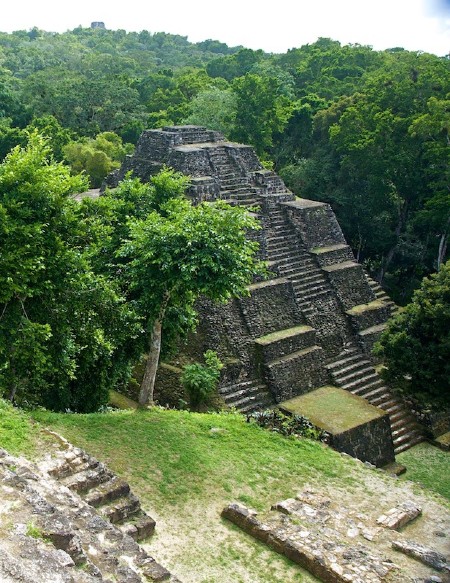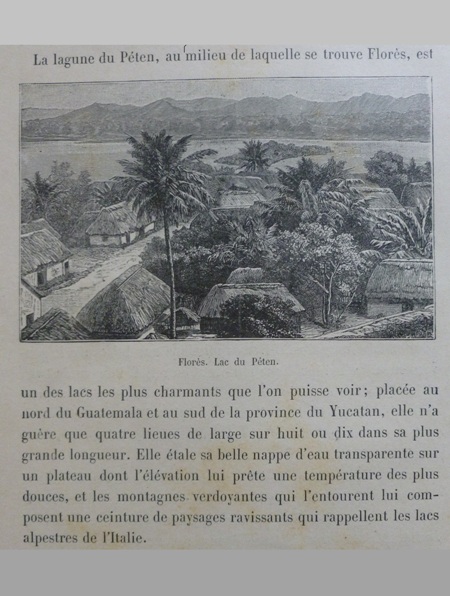Multiples adventures
Dominicans and Franciscans in Maya land - XVIth century
A trip by Las Casas to Tabasco and Chiapas
Pedro de Barrientos in Chiapa de Corzo
Las Casas against the conquistadores
Fuensalida and Orbita, explorers
Numerous studies
An ethnologist friar, Diego de Landa
Two teachers, Juan de Herrera and Juan de Coronel
Two historian friars, Cogolludo and Remesal
A multitude of buildings
A Franciscan turned architect: Friar Juan de Mérida
The Valladolid convent in the Yucatán
The Izamal convent and its miracles
In the Yucatán, a church in every village
A Dominican nurse, Matías de Paz
A difficult task: evangelization
The creation of the monastery of San Cristóbal
The Dominican province of Saint-Vincent
An authoritarian evangelization
Franciscans and the Maya religion
The failure of the Franciscans in Sacalum, the Yucatán
Domingo de Vico, Dominican martyr
The end of the adventure
Additional information
The Historia Eclesiástica Indiana of Mendieta
The road of Dominican evangelization in Guatemala
The convent of Ticul, as seen by John Lloyd Stephens
The Franciscans in the Colca valley in Peru
The convent route of the Yucatán in the XVIth century
The dominican mission of Copanaguastla, Chiapas
Available upon request: -
general information upon Maya countries, - numbered texts
on the conquest and colonization
of Maya countries
Address all correspondence to:
moines.mayas@free.fr
|
FUENSALIDA AND ORBITA, EXPLORERS
|
The forest, east of lake Peten Itza, Yaxha Mayan ruins
In 1618, two Franciscan missionaries, Fray Bartolomé de Fuensalida, mission’s commissary, and Fray Juan de Orbita, set out from Mérida to convert the Itzá to Christianity. The Itzá was a Maya group who inhabit an independent Indian kingdom in the Petén department of Guatemala, in and around the city of Tayasal or Noh Petén, later known as Flores, on the lake Petén Itzá. The two Franciscan monks visited Canek (Ajaw Kan Ek’), the ruler of Tayasal. Canek treated them courteously but their visit was ineffective. Father Orbita had the audacity to demolish a large idol in the form of a horse, called Tzimin Chac, the "thunder horse." At last, the Itzá responded that it was not time for them to be Christians.
On March 13, 1697, the Itzá kingdom finally submitted to Spanish rule, represented by a force led by Martín de Ursua, governor of the Yucatán.
Fray Diego López de Cogolludo relates that voyage of discovery through three chapters, inspired on the report of the two friars:
Fuensalida and Orbita are well received at Nohpetén
"After about eight days (which caused the priests much concern) Don Gaspar Cetzal returned, accompanied by the two captains Ah Cha Tappol and Ahau Ppuc who had come to Tipú, and other Itzá Indians, with four large canoes that Canek sent for them. With that good sign, all of them embarked happy and content, after having eaten. They sailed the six leagues to the island from the shore. The Itzás, watching for them so as to know when they were approaching the island, told Canek when the religious were arriving. Canek sent a son-in-law and others of his family in two canoes which sailed out over two leagues to greet them and receive them in his name. They took with them that drink called zacá, with a cocoa liquor which they like a great deal (even though they were barbarians they did not lack their own taste and signs of civility in some things). They arrived at a landing, very close to town, and there the chieftain Canek himself was waiting, with his leaders and a great following of people who had come out to receive them. It was around ten o’ clock at night when they arrived at the island, but there were so many torches of pitch pine or candlewood that everything was bright and easily seen. When the fathers were on shore Canek received them with demonstrations of great affection and good will, and was very pleased. The religious were placed in a house, not too large but sufficient for their needs, situated about twenty paces from the large home or palace where he resided. According to their custom he gave them two large barbacoas, for beds, and then quartered all the others nearby who had come with them."
(Diego López de Cogolludo, Historia de Yucatán, Book 9, Chapter 8)
They try to convert the Itzá Indians
"Each of the religious had a holy Crucifix in his hand, and Father Commissary Fuensalida began to tell them, about their blindness in adoring the devil in idols and the vanity of so many false gods. And continuing with great eloquence (since he was so fluent in the language and expert in their writing, in addition to his conviction), he explained the sacred mystery of the Incarnation of the Divine Word, and many other things. […]"
"The Indians listened with great attention to Father Commissary Fuensalida’s sermon. But they replied that they had their prophecies by which they knew they have to become Christians, but that the time had not yet come. They told the priests to return some other time because they did not wish to be Christians now."
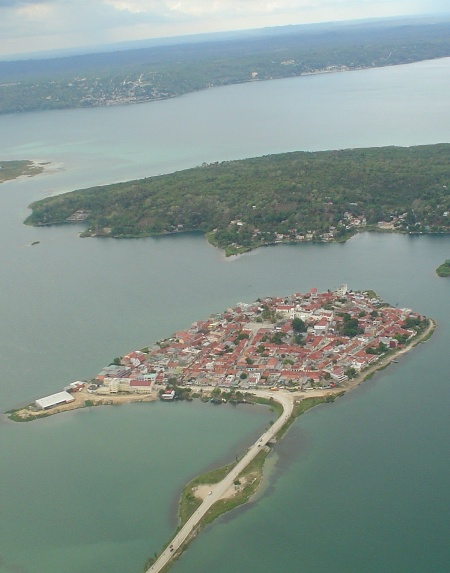
The town of Flores, built on an island of lake Petén Itzá
They visit the village
"In spite of the rejection expressed by their leaders, the Itzás accompanied the missionaries and took them to see the village, whose many houses and living quarters (the religious counted up two hundred houses there) were on the lower part of the island, near the lake shore, while in the middle and upper part were the sanctuaries and temples of their infernal and false gods, many of them very large and well made, like the biggest churches in the Indian villages of our province of Yucatán, which may shelter each one more than one thousand persons."
They discover a statue in the form of a horse
"Entering one of them, they saw in the middle of it a great idol in the form of a horse, made of lime and stone. It was as though it were seated on the temple floor, on its haunches, the legs bent and raised over the forefeet. They adored it as the god of thunder and lightning, calling it Tzimin Chac, that is, horse of thunder and lightning. The reason those barbarians had that idol or statue in the form of a horse and so venerated, it goes back to the time when Don Fernando Cortés left his black horse which was hurt, as I have related previously, when he went through there. The horse died and, by fear they could not return it alive, if he would send for it or even return to get it, they made the statue and placed it in the temple, in a preeminent place among the others gods they adored. So that if the Spaniards were to come back for the horse, seeing how they held this statue in such veneration they would be satisfied they had not been guilty of letting it die. When Cortés had so earnestly entrusted his horse to them, they tried to cure it, and, thinking it was an animal with reason, they fed it chicken and other meat, and gave it sprigs of flowers, as they were accustomed to do with important people when they were sick. All this care and honor (which seemed right to them) simply brought about the death of the poor horse, because he died of hunger. They gave it this name because they had seen some of the Spaniards during Cortés’ journey shooting their guns above the horses while hunting deer, and they thought the animals were the cause of the explosion they made, which sounded to them like thunder, and the light from the touch hole and the smoke of the powder which they considered lightning. Thus, the devil took advantage of all this, together with the blindness of their superstitions, to make their veneration of that statue increase daily, so much so that by the time of the preaching of the religious it had become the principal idol the Itzás worshiped."

2022, November, discovery of a wall of the ancient Tayasal
Father Juan de Orbita destructs the statue
"Father Juan de Orbita, on seeing it, seemed to be filled with the spirit of the Lord (says his companion Father Fuensalida), and in a burst of fervor and zeal for the honor of God, seizing a large stone in his hand he climbed onto the statue of the horse and broke it into pieces, scattering them all over the floor. The enormous throng of Indians, seeing their highly esteemed idol broken, raised a tremendous outery and shouted, “Kill those who have murdered our god; let them die in repayment for the offense they have committed!” All this was with such anger and tumult it was obviously the work of Our Lord that they did not carry it out, since the religious had been happy to die for His Holy Love. Neither Father Orbita nor his companion were perturbed by the clamor of the pagans. Rather, raising the holy Crucifix he had brought, the Father Commissary, with great enthusiasm and courage of spirit –and placing his confidence in God, shouted in a loud voice to the restless throng of Indians: “Know, oh Itzás! That this idol which you adore as your god is nothing but the figure of an irrational beast, as are the deer and other animals you kill in order to eat. […]"
(Diego López de Cogolludo, Historia de Yucatán, Book 9, Chapter 9)
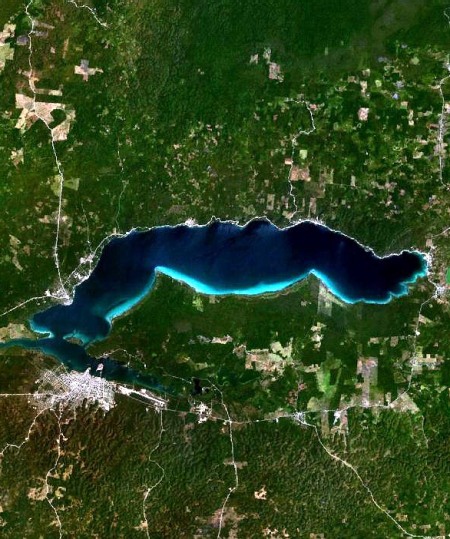
The lake Petén Itzá, satellite view
The two religious escape, crossing the lake
"They said farewell to Canek and the other leaders, who did not wish to give them any Indians to accompany them. Having embarked, they started to sail across the lake. Some of the infidels, probably the most upset and resentful over the breaking of the idol, began throwing rocks from the island shore, continuing this until they were some distance away and out of reach; then the rock throwers shouted loudly, jeering at the religious and ridiculing them. The travellers continued calmly toward the west, when they saw two canoes coming from the left. They approached from the side, rowing rapidly, and in less than an hour, although the Tipú rowers did their best, they caught up with the missionaries’ canoe. They were filled with infidels with their faces and bodies painted black, looking like terrible demons, all armed with arrows and drawn bows and making threatening gestures. As they drew near, almost close enough to board the fugitives canoe, they accosted the priests and Tipú Indians saying they intended to kill them. The fathers and their Indians tried to appease them, especially the Indian Gaspar Cetza, addressing the one who led the Itzás as his “uncle” and asking him why they wanted to shoot them when they were leaving. He replied in great anger that they should never again bring those xolopes (which is what they called Spaniards from the time they saw the first one eating anonas, a tropical fruit). Thus, God was pleased to make them desist and put away their bows at the moment when they had the religious at their mercy and could have killed them, as they threatened to do."
(Diego López de Cogolludo, Historia de Yucatán, Book 9, Chapter 10)
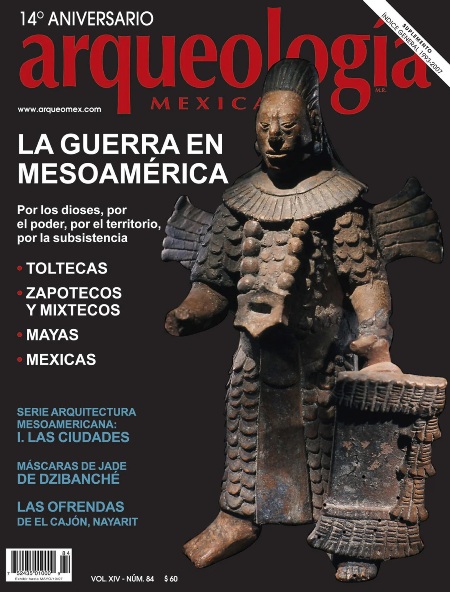
A Maya warrior, in Arqueologia mexicana, 2007, April
THE ITZA
"These Itzá Indians are of Yucatecan origin, descendants of this land of Yucatán. Thus they speak the same Maya language as [those of Yucatán] do. It is said that they left the territory and jurisdiction that today is [that] of the villa of Valladolid and the town of Chichén Itzá, where today there remain some of the large ancient buildings that are seen in this land and which they admired so much when these kingdoms were discovered… And others from neighboring towns left with them.
"Padre Fuensalida says that one hundred years before the Spaniards came to these kingdoms they fled from Chichén Itzá in the age that they call eighth (in their language Uacac Ahau) and settled those lands where they live today. Their flight to an island and such concealed regions was foreseen by the prophecies that they had… that people from a nation that would dominate this land would come from regions to the east. Today those whom they call priests preserve the prophecies (written in their ancient characters) in a book like a history which they call analte. In it they preserve the memory of how much has happened to them since they settled those lands.
"They also say that they went to [those lands] by sea, and in that region that comes out at their lake they have on land a hamlet that they call Zinibacan, which means where they stretched out the sails, because there, having being soaked, they dried them.
"They also say that the occasion of the flight was that, while a great king or lord was readying to be married, during the rejoicings and festivities of the wedding another petty king arrived who was enamored with the bride, and falling with armed men upon those of the fiesta, who had been unsuspecting, and causing some harm among them, kidnapped the betrothed woman. This man was less powerful than the first, so seeing that [the latter] would later make war on him, fearful of the harm that would befall him, he had prepared to flee. So, taking the betrothed woman in his company with many of his people, he went to those lands that were so remote and hidden."
(Diego López de Cogolludo, Historia de Yucatán, Vol. 2, book 9, Chap. 14. Translated by Grant D. Jones, The conquest of the last Maya kingdom, Stanford University Press, 1998)
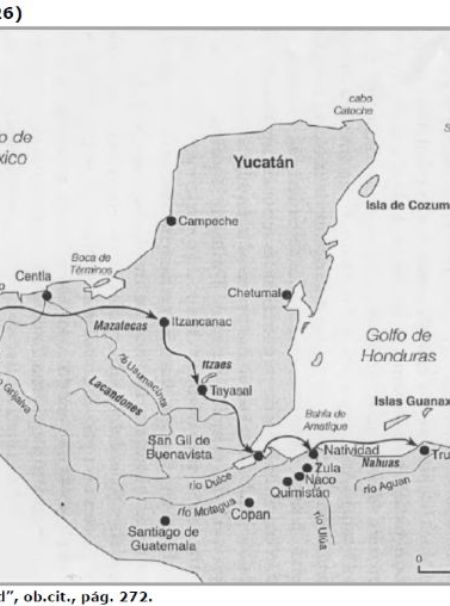
Cortes' route by Tabasco, Guatemala and Honduras, via Tayasal
Cortes in Tayasal, 1525
"On the fifth day, the scouts who went ahead with the guides discovered a great lake which seemed to be an arm of the sea and so large and deep is it that, although its waters are fresh, I even believe that it is so. On a small island in this lake there stood a town which the guides said was the chief one of the Province of Tayasal and that if we wished to reach it we could do so only in canoes; hearing this the Spaniards remained there keeping watch while one returned to report to me what had happened. I halted the people, and went ahead on foot to see that lake and its situation. […]
"I ordered my people to halt and camp at those plantations, taking the best precautions possible; for the guide of Mazatlan told me the people were numerous and warlike and much feared by all their neighbours. The guide then offered to go in that little canoe in which the Indian had come, and cross to that town on the island, a good two leagues distant where he would speak to the lord, whom he knew very well, and who is called Canek, telling him my intentions and the reason of my coming to his country, with which he himself was perfectly acquainted as he had accompanied me. He believed that the chief would be perfectly reassured and would believe what he told him, for he was well known to him and had often been in his house. […] the next day, the chief, himself, escorted by about thirty men in five or six canoes came bringing with him the Spaniard I had given as a hostage. He seemed much pleased at meeting me, and I received him very well.
"As it was the hour of mass when he arrived, I ordered it sung with great solemnity, accompanied by clarions and sackbuts to which he listened with great attention, observing all the ceremonies; and, when mass was finished, one of the Franciscan friars whom I had with me, preached a sermon which was translated by the interpreter so that he could easily understand, touching the matters of our Faith, and giving him to understand with many arguments how there was but one God, and the error of his sect. The chief displayed much satisfaction, and declared that he wished to destroy his idols immediately, and to believe in that God of whom we had spoken, and that he desired to know how he was to serve and honour Him, and that if I wished to come to his town I should see that he would burn the idols in my presence; and he desired that I should leave a cross in his town, as he had been told I had left one in all the towns through which I passed.

Pedro Vega Martínez, La ruta tragica de Hernán Cortes Coatzacoalcos - Las Hibueras, Universidad Juarez Autónoma de Tabasco, 1991
"After this sermon, I again spoke to him, explaining Your Majesty's greatness and how he and all living creatures were the natural subjects and vassals of Your Imperial Highness, and bound to your service; that to those who did so Your Majesty granted all manner of favours which I, in Your Royal name, had dispensed to all those who had offered themselves to Your Royal service and placed themselves under Your Royal rule; I promised the same or greater to him. He answered that, until then, he had never recognised anyone as superior, nor had he known that there was any such one. […] Marina explained everything to him and how I had conquered Mexico, and told him of all the countries I had subjected and placed under the Empire of Your Majesty. He rejoiced greatly on learning this and said he desired to become a subject and vassal of Your Majesty, considering it a joy to be under so great a lord as I told him Your Highness was. He ordered birds, honey, and some gold, and beads made of red shells, which they highly prize, to be brought, and these he offered to me as a present, while I in return gave him some things I had brought with me, which he received with great pleasure. […]
"I asked him, however, to give me the means of crossing that lake, to which he replied that, about three leagues from the place where we were, the lake became shallow, and, by skirting it, I could reach the road opposite his village; but he begged me that, as my people were coming round the lake, I would accompany him in his canoe to visit his town and house where he wished to burn the idols and have a cross made for him. To please him, although it was against the will of my people, I embarked, with about twenty of my men, most of them archers, in his canoe and went to his town with him, where I spent the rest of the day in festivity. At nightfall, I took leave of him, and he gave me a guide with whom I entered the canoe and returned to sleep on land, where I met many of my people who had come round the lake to a place where we passed the night. In this town, or rather at the plantations, I left a horse which got a splinter in his foot and was unable to go on; the chief promised to cure it but I do not know what he will do with him.
(The Five Letters of Relation from Fernando Cortes to the Emperor Charles V, Fifth Letter, Translated by Francis Augustus MacNutt, 1908)
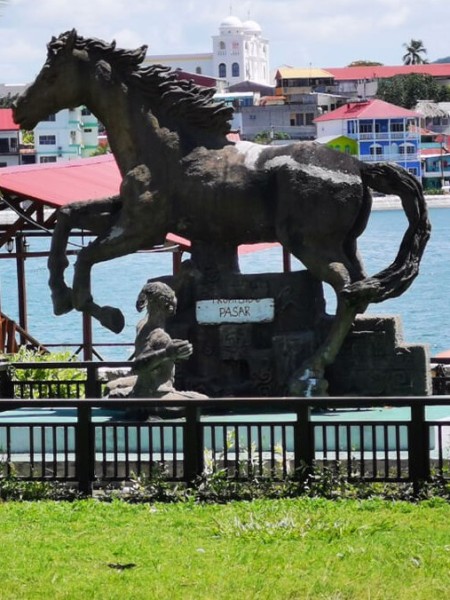
A statue in the Malecón de San Miguel in Flores: the Cortes' stone horse of Tayasal
The Spanish conquistadors enter to Tayasal (1697):
"The circuit of the shores of that great lake, which is called Chaltana, is more than twenty-six leagues. Its length is much greater than its width; in some places it is fathomless, in others thirty fathoms deep, and from this and its continual waves it very much resembles the sea.
"It is very delightful and pleasant, and its waters are very sweet, clear, and light; here is a multitude of large, middle-sized, and small fish, very well flavoured, and good to eat; and there are also icoteas, fresh-water tortoises, and other similar animals. The lake has creeks and arms in all directions, numerous streams fall into it, and it is secure from pirates, as it has no outlet for its waters anywhere, unless there be a subterranean one.
"The Indians had innumerable canoes upon it, for on the day of the assault and capture of the Peten more than five hundred and fifty canoes were taken, merely of those that had been abandoned.
"In the narrowest part of this lake, at the distance of two leagues from the mainland, is the great island on which stood the capital, called Tayasal, or Taisa.
"This island is very steep and lofty, with a table-land at the top; its extent is equal to that covered by the town of San Francisco de Campeche, about three-quarters of a league.
"It was all covered with houses, some with stone walls to the height. of about a yard, and of wood above that, with straw roofs, and others only of wood and stone.
"There were no streets formed, and the insides of the houses were filthy and unswept; the inhabitants lived in a brutal way, all the members of one family, however numerous, occupying the same house, whence it arose that the number of Indians in that island was very great. […]

Flores, November 2024, the lake level rose following a tropical hurricane and flooded part of the city
"Of the twenty-one Cues, or temples, which General Ursua found on the island, the largest was that in which the high-priest Quincanek officiated. It was of square form, with a handsome parapet, and was approached by nine steps, all of beautiful stone, and each front of the building was about twenty yards long and very high.
"On the upper step, by the entrance, was an idol of human form with a bad countenance, sitting on his heels, and in the temple in front was another idol of unwrought emerald, which those infidels called the God of Battles: it was a span long, and remained in the possession of General Ursua. Above it was another of gypsum, with the face marked with mother-of-pearl, forming a sun and its rays; and in its mouth was inserted teeth taken from the Spaniards whom they had killed.
"In the midst of the temple, which was formed like a castle, there was hanging from the top, by three strips of spun cotton of different colours, a leg-bone half-decayed; and below it hung a little bag, three-quarters of a yard long, containing little pieces of bone, which were also decayed; and on the ground beneath were placed three braziers for burning perfumes or incense, with storax and other aromatic substances in them, which they used to burn in the sacrifices, and some dry maize-leaves ; on the top of the upper part of this leg-bone was set a crown.
"It was explained that these bones were the fragments of what remained of a great horse which had been left in their care by a king who had passed that way a long time before : from which it was certain that it was the horse of Fernando Cortez.
"Another great temple, built in the same way, was that of the Canek. In it was a great table or altar of stone for sacrifices, with seats all round it, highly polished. It contained also many statues of stone, wood, and gypsum, well sculptured, though some were horrible figures. In the Canek's house, too, there were several idols, a table for sacrifices, and the Analtches, or histories of all that happened to the people.
"In another temple, which was under the care of a priest named Tut, there was a hideous idol which they said had predicted the arrival of the Spaniards, and offered his assistance in defeating them, on condition of their being sacrificed to him. But the day having come and the Spaniards having landed, and seeing his countrymen giving way, the priest Tut began in their presence to implore the aid of his false god, reminding him of his promise. But when he saw the Itzaes fly, the priest began to beat the idol, and after abusing it in very opprobrious terms, fled with the rest and threw himself into the lake."
(Juan de Villagutierre Sotomayor, Historia de la conquista de Itzá, 1701, Book VIII, Chapters XII, XIII)
Flores in the XIXth century. In Désiré Charnay, A travers les foręts vierges, Librairie Hachette, Paris 1894
2025 "Friars and Mayas"
|
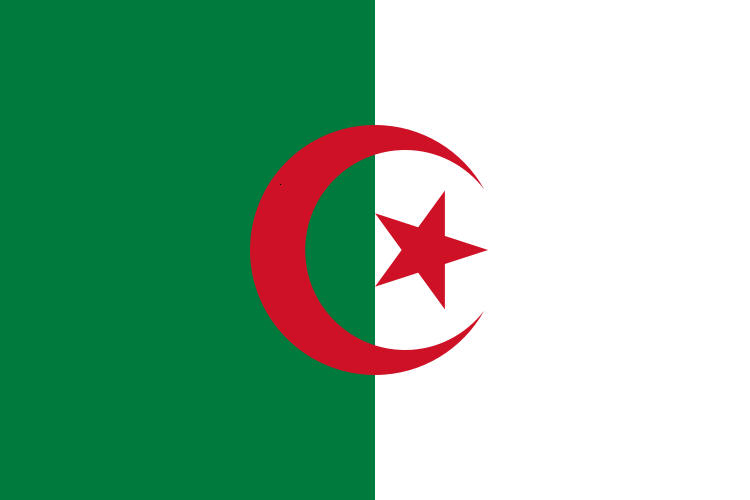

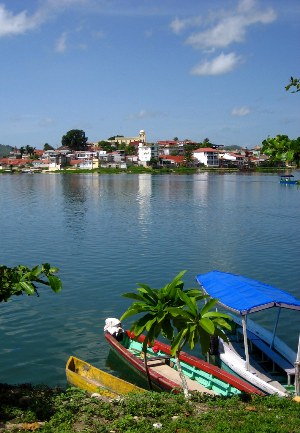
The lake Petén Itzá, today
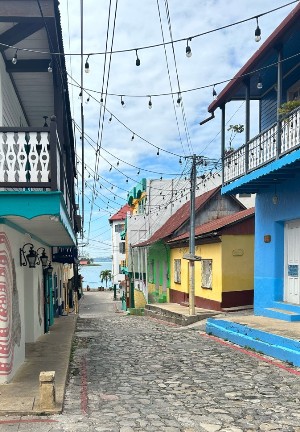
A street at Nohpetén / Tayasal / Flores, today
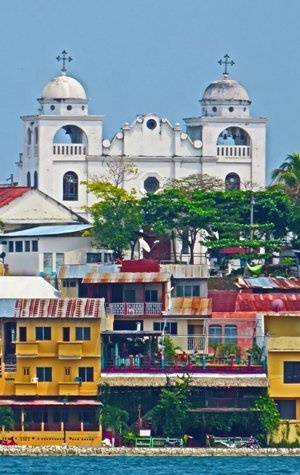
Towering Flores island, the cathedral of Nuestra Seńora de los Remedios y San Pablo de Itzá, built on the place of the great temple housing the horse statue
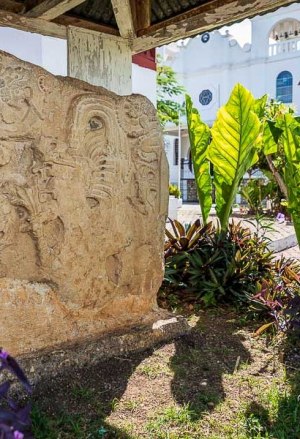
Remains of the old Tayasal: a Maya stele in front of the church of Flores
Letter from Don Martin de Ursua, to the King of the Indians
“ […] And now I say to you also that my wish is to love you, nor do I ask anything of you save that you know our true God and that you render homage to our true King and Lord. And as a sign that this is my intention and that I do not wish to make war upon you, and for the sake of the peace which you ask of me, I send you, in the name of our king and Lord Don Carlos, these Fathers of Saint Francis [Friar Andrés de Avendańo and Friar Antonio de San Roman] in order that they may preach to you and instruct you in Christianity and in the Mysteries of our holy Faith, drawing you from the shadows in which you are living, through the trickeries of the Devil. They will teach you the true road to Heaven. And what the true God orders us to do, let us do, for the salvation of our Souls. Therefore love them much and reverence them as guides for your Souls along the true road, as messengers of God and as your Spiritual Fathers. And thou, Canek, shallt make reply to this my Letter so that I may know in what manner thou givest thyself up to the obedience and service of our great King, together with all the Ytzaex. And if you act in a contrary way, I protest that any harm that may come upon you will be by our own fault, and not because of that of our great King, nor mine. This letter was written in this City of Tihoo, which is Merida, on the eighth day of the month of December, in the Year of the Birth of Christ our Redeemer, four twenties, which are counted by five four hundreds, with fifteen more.” [December 8, 1695]
(In Dr. Don Francisco de Elorza y Rada, Abbot of Barasoayn, A narrative of the conquest of the province of the Ytzas, Les Editions Genet, Paris, 1930)
